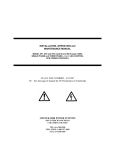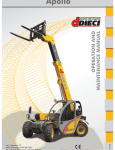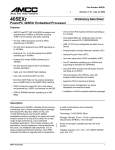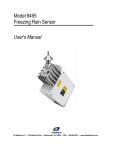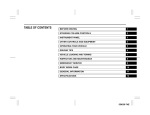Download ZF1 Series 15-70 Amp User Manual
Transcript
INSTALLATION, OPERATION and MAINTENANCE MANUAL MODEL ZF1, ZF2 and ZF3 rated 15, 25, 40 & 70 AMP SINGLE and THREE PHASE - 2 or 3 LEG CONTROL SOLIDSTATE RELAY (SSR) POWER CONTROLS UL/cUL FILE NUMBER – E151547 CSA FILE NUMBER – LR91210 CE – See last page of manual for CE Declaration of Conformity. AMETEK HDR POWER SYSTEMS 3563 INTERCHANGE ROAD COLUMBUS, OHIO 43204 TEL: 614-308-5500 TOLL FREE: 1-888-PWR-CNTL (797-2685) FAX: 614-308-5506 SCR Power Controls/Systems & Power Supplies Dear Client: On behalf of all of AMETEK HDR's employees, I want to take this opportunity to "thank you" for purchasing an AMETEK HDR Power Systems' SCR Power Control. We believe AMETEK HDR represents the best overall solution to your SCR Power Control needs in the industry today. We do this by providing a quality manufactured reliable unit with fast, on-time delivery and a competitive price. All of our employees are dedicated to your success. If you have any questions, comments or concerns, please call me toll free at 1-888-PWR-CNTL (797-2685). Sincerely, AMETEK HDR POWER SYSTEMS George A. Sites Vice President GAS/be 3563 Interchange Road Columbus, OH 43204-1400 USA Telephone: 614-308-5500 1-888-PWR-C NTL FAX: 614-308-5506 REVISION PAGE Page Change 28 1 Revision Date Added EMC statement to EC Declaration 11-00 NOTE: ALL SPECIFICATIONS SUBJECT TO CHANGE WITHOUT PRIOR NOTICE COPYRIGHT 2003 AMETEK HDR POWER SYSTEMS TABLE OF CONTENTS Para. Title Page Section 1 - DESCRIPTION 1-1 1-2 1-3 1-4 1-5 1-6 Models Covered...................................................................................................1 General Description..............................................................................................1 Applications .........................................................................................................1 Specifications.......................................................................................................1 Options ................................................................................................................2 Operation.............................................................................................................2 Section 2 - INSTALLATION 2-1 2-2 2-3 Mounting .............................................................................................................5 Line/Load Power Wiring ......................................................................................5 Safety Issues ........................................................................................................6 Section 3 - COMMAND SIGNAL CALIBRATION 3-1 3-2 3-3 3-4 Zero and Span Adjustments..................................................................................19 Command Indicator..............................................................................................19 Remote Manual Control.......................................................................................19 Process Command Signal .....................................................................................20 Section 4 - MAINTENANCE 4-1 4-2 4-3 Environmental Concerns ......................................................................................24 Line/Load Power Connections .............................................................................24 Troubleshooting Typical Symptoms .....................................................................24 Section 5 - SERVICE AND SPARE PARTS 5-1 5-2 5-3 Customer Service.................................................................................................26 Spare Parts...........................................................................................................26 Warranty..............................................................................................................26 i TABLES and ILLUSTRATIONS LIST TABLES Table 1 2 3 4 Title Page Specifications............................................................................................................. 1 % Output Voltage at Various Input Command Levels ................................................ 3 Fusing Requirements.................................................................................................. 6 Minimum/Maximum Currents .................................................................................... 7 ILLUSTRATIONS Figure 1 2 3 4 5 6 7 8 9 10 11 12 13 14 15 Title Page Line/Load Power Wiring ZF1 Models ........................................................................ 8 Line/Load Power Wiring ZF2 Models ........................................................................ 8 Line/Load Power Wiring ZF3 Models ........................................................................ 9 Outline & Mounting Dimensions – ZF1 15, 25 & 4 0A............................................. 10 Outline & Mounting Dimensions – ZF1 70A ............................................................ 11 Outline & Mounting Dimensions – ZF2 15, 25 & 40A ............................................. 12 Outline & Mounting Dimensions – ZF2 70A ............................................................ 13 Outline & Mounting Dimensions – ZF3 15, 25 and 40A ........................................... 14 Outline & Mounting Dimensions – ZF3 70A ............................................................ 15 24 VAC Transformer Dimensions & Schematic........................................................ 16 Single-Phase Fuse Block Dimensions ....................................................................... 17 Three-Phase Fuse Block Dimensions........................................................................ 18 Remote Manual Control (-V) Models....................................................................... 21 Process Command Signal (-V) Models..................................................................... 22 Process Command Signal (-C) Models ..................................................................... 23 ii DRAWING LIST Schematic, ZF1 15 Thru 40A (-C) ................................................................................. S2710000 Schematic, ZF1 15 Thru 40A (-V)................................................................................. S2710001 Schematic, ZF1 70A (-C) .............................................................................................. S2710079 Schematic, ZF1 70A (-V) .............................................................................................. S2710080 Schematic, ZF1-C Firing Circuit .................................................................................... S2078000 Assembly, ZF1-C Firing Circuit .................................................................................... M2078000 Schematic, ZF1-V Firing Circuit.................................................................................... S2079000 Assembly, ZF1-V Firing Circuit.................................................................................... M2079000 Schematic, ZF2 15 thru 40A (-C) .................................................................................. S2710017 Schematic, ZF2 15 thru 40A (-V) .................................................................................. S2710018 Schematic, ZF2 70A (-C) .............................................................................................. S2710081 Schematic, ZF2 70A (-V) .............................................................................................. S2710082 Schematic, ZF2-C Firing Circuit .................................................................................... S2081000 Assembly, ZF2-C Firing Circuit .................................................................................... M2081000 Schematic, ZF2-V Firing Circuit ................................................................................... S2082000 Assembly, ZF2-V Firing Circuit .................................................................................... M2082000 Schematic, ZF3 15 thru 40A.......................................................................................... S2710034 Schematic, ZF3 70A ..................................................................................................... S2710083 Schematic, ZF3 Firing Circuit........................................................................................ S2099148 Assembly, ZF3 Firing Circuit......................................................................................... M2099148 NOTE: If full size drawings are required, contact HDR inside sales and request the desired drawing(s) by the drawing number listed above. iii Section 1 - DESCRIPTION 1-1 MODELS COVERED This manual covers the ZF1, ZF2 and ZF3 models rated 15, 25, 40 & 70 amperes and their options. 1-2 GENERAL DESCRIPTION The ZF1, 2 and 3 models are solid-state, single and three-phase, zero-fired (ZF) Solidstate Relay power controls which will operate on line voltages up to 600 VAC. They accept most all standard process command signals and regulate the output voltage. Zero and Span Multi-turn potentiometers are provided to ease calibration. An isolated base Solid-State-Relay (SSR) module is used for power switching in each controlled phase. This module contains two SCRs connected back to back and a zero-crossing detector. The firing circuit is based on common integrated circuits that provides very reliable operation. Terminals are provided to ease installation. 1-3 APPLICATIONS A variable time base firing circuit is used to provide precise control of power to resistive loads. These units should never be used on inductive loads. However, they are versatile enough to be used in place of mechanical contactors and mercury relays on dryers, kilns, ovens, environmental chambers, extruders, molding equipment, and other types of equipment which uses resistive heat. 1-4 SPECIFICATIONS TABLE 1 CONTROL METHOD - Zero firing of back to back SCRs in each phase. VOLTAGE RATING - Up to 600 VAC, 1 or 3 Ph., 50/60 Hz. CURRENT RATING - 15, 25, 40 & 70 Arms. COMMAND SIGNAL - 4-20 ma, 0-5 VDC/0-10 VDC, Manual Control. ISOLATION - 2500 Vrms from line/load to command signal to ground. ADJUSTMENTS – Zero and Span, Multi-turn. AMBIENT TEMPERATURE – Operating, 0 to 50C; Storage, -10 to 70C. AGENCY LISTING – 15, 25, 40A UL/cUL Listed, CSA Certified, CE Compliant. 70A UL/cUL, CE Compliant 1 1-5 OPTIONS Three options are available: a Fuse Kit, a 24 VAC Control Transformer for the -V Models and heat sink thermostat(s). The Fuse Kit (Option FK) consists of a Semi-Conductor Fuse and fuse block. It is the user's responsibility to mount this fuse kit. The (-V) models require 24 VAC (3VA) control power. An appropriately sized transformer (Option TX) is available with 120, 240, 400, 480 or 575 VAC primaries. Over-temperature thermostats are mounted on each heat sink. Specify NO for normally open or NC for normally closed. 1-6 OPERATION The power is controlled by the switching action of two SCRs connected in a back to back configuration in each controlled phase. The zero crossing detector built into the solid-state relay module synchronizes the gating of these SCRs with the line frequency (either 50 or 60 HZ). The firing circuit provides timing pulses to the SSR proportional to the command signal. These pulsed determine the output level. The output may be adjusted by a voltage or current signal from a process controller. Zero and Span controls allow the user to calibrate the power controller’s output to the process signal. Terminals are also available for connection of a remote manual potentiometer on the (V) model. WARNING Hazardous voltages exist at the power controller heat sinks and at the load at all times when the input voltage is connected. This condition exists even when the controller is set to deliver zero output. NOTE: On the (-V) models, the zero control can be used as a manual control, or a remote manual control can be connected. The power controller regulates the output voltage by proportionally controlling the number of AC cycles “on” versus the number “off”. Because the voltage is “turned on” at zero crossing, very little radio frequency interference (RFI) is generated and 2 the power factor (PF) is near unity. Keep in mind that ZF units can only be used on resistive loads. If an inductive load or a load with a large resistance change (instantaneously or cold to hot) is being used, a phase fired (PF) power control should be used. TABLE 2 % OUTPUT VOLTAGE AT VARIOUS INPUT COMMAND LEVELS Ma Input % Output Voltage 4 0 5 10 6 30 7 41 8 53 9 59 10 64 11 68 12 71 13 76 14 80 15 85 16 88 17 91 18 95 19 98 20 100 3 Table 2 shows the percent output voltage at various input command signal levels. The variable time base firing circuit picks the minimum length time base to maintain as constant a power level to the heating elements as possible. By doing this, thermal shock and mechanical abuse to the heating elements is reduced and the life expectancy of the element should increase. NOTE: The percent output voltage for any given command signal Is affected by the exact setting of the zero and span potentiometers. Table 2 is to be used only as a reference. 4 Section 2 - INSTALLATION 2-1 MOUNTING Prior to mounting, verify the voltage and current rating of the power controller. The information is provided on the nameplate located on the left side of the unit. Determine the mounting dimensions from the outline drawing Figures 3, 4, 5, 6, 7 or 8. Mount the unit with line/load terminals to the top so that airflow is upward through the heat sink fins. Ensure that airflow is unrestricted. Mount the fuse kit and the 24 VAC control transformer as close as possible to the power controller. Refer to Figure 10 for the control transformer’s mounting dimensions and schematic. Use Figures 11 and 12 for single and three-phase fuse block dimensions. WARNING Branch circuit overcurrent protection is required to be provided in accordance with the national and/or local code of the inspecting authority or equivalent. If it is desired to protect the SCRs, fast clearing semiconductor fuses must be added to the system. Table 3 shows the fuse voltage, fuse current, fuse maximum I2T rating and conditional short circuit current (CSCA) rating for each of the power control’s ratings. 2-2 LINE/LOAD POWER WIRING Connect the line/load using appropriately sized and insulated wire/cable per any national or local codes based on the voltage and current rating of the power controller. Torque the line/load power connections to 25 in-lbs. minimum. Refer to Figures 1, 2 or 3 for all power connections. NOTE: a minimum rating of 75°C wire is required by UL for all power connections to the power control. 5 TABLE 3 UNIT CURRENT (A) FUSE VOLTAGE FUSE CURRENT FUSE I2 T CSCA 15A 700 20 157 200,000 25A 700 30 427 200,000 40A 700 50 950 200,000 70A 700 80 4085 200,000 NOTE: The Conditional Short Circuit Current (CSCA) rating is the maximum current the fuse can safely clear and this rating must be higher than the current the branch circuit can supply. 2-3 SAFETY ISSUES The rated operational voltage of each power controller is shown on it’s nameplate, i.e. 120V, 240V, 400V, 480V, or 575V. The power controller is designed to operate between +10% and –15% of this rated operational voltage in an Over Voltage Category III environment. WARNING Power control units are not suitable to provide isolation due to the use of semiconductors and other components that allow a small current to flow from line to load even when the unit is in the nonconducting mode. The voltage drop across the switching semiconductor while in the conducting mode is approximately 1.5 volts and is somewhat a function of current. To calculate the power control’s power loss, multiply the load current times 1.5 time the number of controlled phases. 6 The minimum operational current and the maximum off state current for each unit is shown in Table 4. The power controls described in this instruction manual are designed to operate in a pollution degree 2 environment. TABLE 4 UNIT CURRENT (A) MINIMUM OPERATING CURRENT (ma) MAXIMUM OFF CURRENT (ma) 15A 100 15 25A 100 15 40A 100 15 70A 100 15 HAZARDS EXIST DANGEROUS VOLTAGES EXIST 7 Figure 1 – LINE/LOAD POWER WIRING ZF1 MODELS Figure 2 – LINE/LOAD POWER WIRING ZF2 MODELS 8 Figure 3 – LINE/LOAD POWER WIRING ZF3 MODELS Figure 4 - OUTLINE and MOUNTING DIMENSIONS ZF1 - 15, 25 & 40A 9 Figure 5 – OUTLINE and MOUNTING DIMENSIONS ZF1 – 70A 10 Figure 6 – OUTLINE and MOUNTING DIMENSIONS ZF2 – 15, 25 & 40A 11 Figure 7 – OUTLINE and MOUNTING DIMENSIONS ZF2 – 70A 12 Figure 8 – OUTLINE and MOUNTING DIMENSIONS ZF3 – 15, 25 & 40A 13 Figure 9 – OUTLINE and MOUNTING DIMENSIONS ZF3 – 70A 14 15 Figure 10 – 24 Vac Transformer 16 Figure 11 – SINGLE-PHASE FUSE BLOCK DIMENSIONS 15/25 AMP 40/70 AMP 17 Figure 12 – THREE-PHASE FUSE BLOCK DIMENSIONS 15/25 AMP 40/70 AMP 18 Section 3 - COMMAND SIGNAL CALIBRATION 3-1 ZERO AND SPAN ADJUSTMENTS On (-V) models (voltage input) the Zero potentiometer has both positive and negative voltages available making it usable as a manual or zero control. By turning the Zero control clockwise the unit's output voltage will increase proportionally to the adjustment. Turning it counter-clockwise will decrease the output, or zero the output for a non-zero based command signal. Zero is mid rotation. On (-C) models (4-20ma current input only) the Zero potentiometer has only the negative voltage available and, therefore, can only be used for zeroing the output for a 4-20ma command signal. Because the power controller pulls it’s operating power from the 4-20ma source, no other device can be series or parallel connected. The Span potentiometer on both (-V) & (-C) models is used to adjust the maximum output level. It will adjust for either a remote manual control or a command signal input. Clockwise adjustment increases the output while counter-clockwise adjustment decreases the output. Due to some interaction between controls, it may be necessary to repeat both the zero and span adjustments. 3-2 COMMAND INDICATOR The Command Indicator is a green Light Emitting Diode (LED) located between the Zero and Span controls. The flash rate of this LED will vary in synchronization with the output of the unit. The rate will be faster with higher outputs and slower with lower outputs. 3-3 REMOTE MANUAL CONTROL (-V MODELS ONLY) NOTE: A remote manual control cannot be used on a (-C) model. Start with the Zero Control set approximately at mid rotation and the Span Control set minimum (counter-clockwise). Connect a 5K ohm remote manual control as shown in Figure 13. With the unit energized and the remote manual control fully counterclockwise, adjust the Zero Control until the unit is just off. Next turn the remote manual control fully clockwise and adjust the Span Control until the desired output voltage is reached. This procedure may have to be repeated since some interaction between the Zero and Span Controls exist. The exact setting of the zero and span controls can affect the linearity, so be as precise as possible. 19 3-4 PROCESS COMMAND SIGNAL This procedure is similar to the Remote Manual Control procedure. Start with the Zero Control set approximately at mid rotation and the Span Control set at minimum. Connect the Command Signal with the (-) on terminal 1 and the (+) on terminal 2. Refer to Figure 14 for (-V) Models, and to Figure 15 for (-C) Models. Then energize the unit. With the Command Signal at minimum, adjust the Zero Control so the unit is just off (zero output voltage); next, with the Command Signal at full output, adjust the Span Control so the output voltage is at the desired output level. Repeating this procedure may be necessary due to some interaction between the Zero and Span Controls. NOTE: The (-V) models will accept a 0-5 VDC/0-10 VDC, 4-20 ma or a manual control input. The (-C) model will only accept a 4-20 ma input and cannot be series or paralleled with other units. 20 Figure 13 - REMOTE MANUAL CONTROL (-V) MODELS 21 Figure 14 - PROCESS COMMAND SIGNAL (-V) MODELS 22 Figure 15 - PROCESS COMMAND SIGNAL (-C) MODELS 23 Section 4 - MAINTENANCE 4-1 ENVIRONMENTAL CONCERNS Always verify that the power control is mounted in a clean, dust free environment. Clean the heat sink(s) and printed circuit board periodically so no dust or dirt accumulates on the unit. Dust or dirt on the heat sink fins can prevent proper airflow and heat dissipation causing overheating of the semiconductors. Conductive dust or dirt can cause shorts or arcing, which can cause damage to the unit. WARNING DISCONNECT ALL SOURCES OF POWER TO THE POWER CONTROLLER PRIOR TO CLEANING. THE UNIT IS NOT SUITABLE FOR HOSE DOWN CLEANING. USE VACUUM, BRUSH OR LOW PRESSURE AIR. 4-2 LINE/LOAD POWER CONNECTIONS Periodically turn the power off to the ZF1 and check for corrosion and tightness of the power connections. If any corrosion is evident, clean the cables and connectors and reconnect them. Tighten them to 25 in-lbs. 4-3 TROUBLESHOOTING TYPICAL SYMPTOMS Any one of the following problems can be repaired in the field. Any other problems require returning the power controller to HDR for servicing. 1. Symptom - No output. Cause - Open fuse or no 24 VAC control power on (-V) Models. Solution - Disconnect the input power and check the fuse, replace the fuse if faulty. If the fuse checks ok, verify the 24 VAC control power on terminals 4 & 5 if the unit is a (-V) Model. If neither of these solve the problem, contact the factory. 2. Symptom - Full output regardless of command signal level. Cause - Shorted SSR module or defective firing circuit. Solution - Readjust the zero and span controls. If this does not help, disconnect the input power and remove the firing circuit. Re-energize, if the output is on full, replace the SSR module. If the output is off, then most likely the firing circuit is defective. Consult the factory. 24 3. Symptom - The unit is not variable from 0 to full output. Cause - Defective firing circuit. Solution - If neither of the first two symptom/solutions are the answer, order a replacement firing circuit from the factory. 25 Section 5 - SERVICE AND SPARE PARTS 5-1 CUSTOMER SERVICE If you have operational problems which cannot be resolved using this manual, please contact the Service Department at AMETEK HDR. Our normal work hours are 8 a.m. to 3:30 p.m., U.S.A. EASTERN TIME ZONE, Monday through Friday. TELEPHONE: 1-888-PWR-CNTL (797-2685) OR 614-308-5500. Our answering machine at 614-308-5500 will answer after hours and we will return your call the next working day. FAX: 614-308-5506. 24 hours per day automatic answering. EMERGENCY: Pager 1-800-759-8888, PIN # 1245473. 5-2 SPARE PARTS Inside Sales should be contacted for any spare parts order whether routine or emergency during normal working hours. All after hours requirements should be called in on our 614-308-5500 answering machine. Please have as much information available as possible pertaining to the model number, serial number, AMETEK HDR order number and parts required. A purchase order number should be available. 5-3 WARRANTY AMETEK HDR warrants that the equipment delivered will be free from defects in workmanship and material for a period of five years from the date of shipment. AMETEK HDR will repair or replace, at AMETEK HDR's option, any part found defective during proper and normal use, provided that written notice of the nature of the defect is received by AMETEK HDR within the five year warranty period and that the customer returns the part to AMETEK HDR freight paid both ways. This warranty is not transferable by the initial end user. AMETEK HDR MAKES NO OTHER WARRANTIES, EXPRESSED OR IMPLIED (INCLUDING, WITHOUT LIMITATION, MERCHANTABILITY, FITNESS FOR PURPOSE, OR AGAINST INFRINGEMENT OF ANY PATENT) EXCEPT AS EXPRESSLY PROVIDED HEREIN. 26 THE REMEDY OF REPAIR OR REPLACEMENT IS CUSTOMER'S SOLE AND EXCLUSIVE REMEDY AND WILL SATISFY ALL OF AMETEK HDR'S LIABILITIES, WHETHER BASED ON CONTRACT, NEGLIGENCE, TORT, PRODUCT LIABILITY, STRICT LIABILITY, OR OTHERWISE. IN NO EVENT WILL HDR BE LIABLE FOR INCIDENT OR CONSEQUENTIAL DAMAGES, NOR IN ANY EVENT SHALL HDR'S LIABILITY EXCEED THE UNIT PRICE OF ANY DEFECTIVE PRODUCT OR PART. 27 EC DECLARATION OF CONFORMITY WE: AMETEK HDR POWER SYSTEMS 3563 Interchange Road Columbus, Ohio 43204 - USA Declare under our sole responsibility that the products listed below and bearing the CE label: Type: SCR power controllers with the following model designations and current ratings: ZF1, ZF2, ZF3, PF1, PF3 - 15, 25, 40, 60, 70, 90, 120, 180, 225, 350, 500, 650, 800, 1000 and 1200A. SHZF1, SHPF1 - 15, 30, 40, 60, 70, 90 and 120A SHZF2, SHZF3, SHPF3 - 15, 25, 30, 60, 90, 120, 180 and 225A SCZF1, SCPF1 - 15, 25, 40 and 65A To which this declaration relates is in conformity with the technical requirements of the following documents: Title: Low-voltage switchgear and control gear No. Year: IEC 947-5-1 1990-03 Low Voltage Directive No. Year: IEC 73/23/EEC 1973-02 Degrees of protection provided by enclosures (IP Code): No. Year: IEC 529-2nd Edition 1989-11 Electromagnetic Compatibility (EMC) No. IEC 89/336/EEC Year: 1989-05 Warning All phase-fired (PF) controllers will require line filters and possibly shielded cables to meet the EMC requirements. (Environmental protection classification IP00 - for mounting inside an enclosure) Note: Characteristics are according to manufactures specifications. Name: George A. Sites Title: Vice President Date: November 9, 2000 Declaration written in accordance with I.S.O. – IEC/22 Guide. 28


































